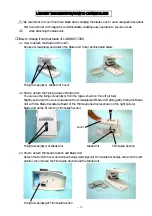
Wartungs- und Reparaturanleitung
Alphaclassic / Betaclassic
Maintenance and Repair Instruction
1118
1118.0XGB_ 06
Page: 5
1. Design and functional description
The main components:
- Transformer (1118.02/03)
- Charging unit, Batteries (1118.02/03)
- DC motor (1118.02/03)
- Hydraulic pump (1118.02/03)
- Pedal pump
- 6/3 directional valve with selector calotte
- Lowering valve
- Hydraulic pressure lines, hydraulic cylinders
- Lowering valve (check valve)
For further information refer to the technical description and to the operating instructions
Description
1118 is a mobile O.R. table that is also available as a electrical-hydraulic version. Actuation of its hydraulic
cylinders is selected by means of a selector calotte.
A 6/3-channel valve (1) [6 connections, 3 switch positions] is used to control the oil flow. Channels are switched
depending on the position of the selector calotte to either extend or reverse the piston rod of the selected cylinder.
2 combined switch&check valves (2) are assigned to the 6/3-channel valves of the tilting and the
trendelenburg functions. Channels of these combined switch&check valves are opened or closed by means of the
oil flow coming from the 6/3-channel valve.
2 lowering valves (check valves) (2) for tilting and trendelenburg belong to the 6/3 directional valve that are
controlled i.e. opened or closed, by means of the oil flow of the 6/3 directional valve.
The A and B channels of these lowering valves are closed in quiescent position in order to prevent the piston rod
from being pushed back under load.
Depending on the position of the selector calotte the functions “tilting” and “trendelenburg” are actuated.
In neutral position of the selector calotte the height cylinder is selected. Contrary to the tilting and trendelenburg
cylinder, the height cylinder is a single-acting type
To move the table downward the lowering valve (3) must be actuated by means of the separate pedal lever.
- see also the description in the operating instructions.
Transformer and charging unit – only types with electrical option (1118.02)
The O.R. table is supplied with the mains voltage via a 2-conductor cord with a standard inlet-plug and a mains
plug. The transformer is equipped with a voltage selector to adapt the O.R. table correctly to the on-site voltage
(100...240 V). The primary winding consists of four parts – 2x104 V and 2x12V.
To select a voltage of e.g. 230V, all four parts of the winding are connected in series (=232V).
The lower limit of voltages that can be selected is achieved in that both the 104V-windings are connected parallel.
A temperature fuse (133°C) is integrated in the primary winding. This fuse cannot be replaced i.e. the complete
transformer must be replaced if this fuse has blown.
The secondary windings provide 2x14V as a supply voltage for the charger board A3.
The 2 batteries and the 24V-DC-motor are connected to the charger board A3. These 2 parts are located in the
base of the O.R. table.
The AC voltages (2x24V) from the transformer are used to produce 2 charging voltages of 13.75V that are
regulated separately. Each of these voltages is connected to one battery.
Batterien (1118.02/03)
The batteries used for this O.R. table are maintenance-free lead-gel types. These batteries supply the motor with
24V DC, . 2 batteries with are capacity of 7Ah are sufficient for 1118.02 – batteries with a capacity of 15Ah are
used for 1118.03. The period for which the O.R. table can be operated by the batteries depends on the power
consumption of the motor and the time for which the motor is actually running. The nominal current consumption
of the motor is app. 7A.
According to the supplier, the useful lifetime of the batteries is 5-6 years.
This is equivalent to 300 cycles of charging/discharging when the batteries are charged weekly.







































